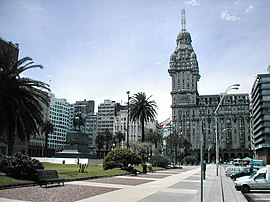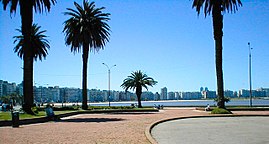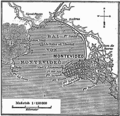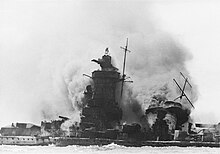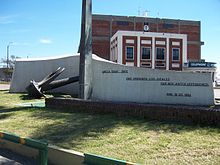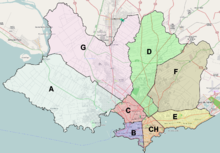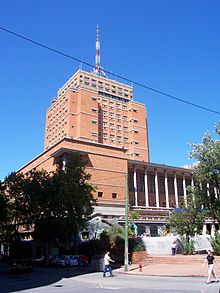Montevideo
| Montevideo | ||
|---|---|---|
|
Coordinates: 34 ° 52 ′ S , 56 ° 10 ′ W Montevideo on the map of Uruguay
|
||
|
Location of Montevideo in Uruguay
|
||
| Basic data | ||
| Country | Uruguay | |
| Department | Montevideo | |
| City foundation | December 24, 1726 | |
| Residents | 1,338,408 (2009) | |
| - in the metropolitan area | 1,968,324 | |
| Detailed data | ||
| surface | 526 km 2 | |
| Population density | 2,545 inhabitants / km 2 | |
| height | 43 m | |
| City structure | 62 barrios | |
| Waters | Río de la Plata | |
| Post Code | 11xxx - 12xxx | |
| prefix | (+598) 2 | |
| Time zone | UTC −3 | |
| City Presidency | Christian di Candia | |
| Website | ||
| Center with the Palacio Salvo | ||
| Promenade in Montevideo | ||
Montevideo [ mɔnteviˈdeːo , Spanish mɔnteβiˈðeo ] is the capital and primate city of Uruguay . The metropolis at the mouth of the Río de la Plata has around 1.3 million inhabitants and is the economic, administrative and cultural center of the country.
Montevideo is one of the ten safest cities in Latin America and, according to a study, is also the South American city with the highest quality of life . In its 2012 study, the Economist Intelligence Unit ranks Montevideo third among Latin American cities and 65th worldwide, behind Buenos Aires and Santiago de Chile .
geography
City structure
Montevideo is divided into 62 barrios . The division of the barrios was subject to changes over the decades. This created new barrios, while others merged or were merged. Many of today's districts of Montevideo, which are not necessarily identical to the structure of the barrios, were geographically independent settlements at the time of their creation, but they were absorbed by the growth of the city. Examples of this are Pocitos or Sayago . Others formed around industrial poles, such as the salt meat factory in Villa del Cerro or the tanneries in Nuevo París . Finally, there were those who developed from the construction of large residential complexes, including Euskal Erría in Malvín Norte and Parque Posadas in Barrio Aires Puros .
|
|
climate
According to Köppen's definition, Montevideo has an ever-humid subtropical climate, which is also known as the subtropical east side climate. It is characterized by its evenly distributed rainfall throughout the year, by mild winters and warm summers. The whole of Montevideo lies in the area of the subtropical high pressure cell of the Atlantic, which brings moist air and thus precipitation over Uruguay. In winter, the wandering low pressure areas of the westerly wind zones can penetrate up to the 32nd parallel and thus also to Montevideo. In addition, the winters are uncomfortably humid and windy. A very important peculiarity of the local climate are the stormy cold air ingress from the south ( Pamperos ), which can lead to an extreme drop in temperature at any time of the year due to the lack of weather barriers (mountains). They invade Montevideo particularly frequently in winter and spring. But warm winds from the northeast can also bring summer temperatures of up to a maximum of 30 ° C. This phenomenon occurs particularly often at the beginning of winter and is called "Veranito de San Juan" by the locals. The annual average temperature is around 16.3 ° C.
| Montevideo (Uruguay) | ||||||||||||||||||||||||||||||||||||||||||||||||
|---|---|---|---|---|---|---|---|---|---|---|---|---|---|---|---|---|---|---|---|---|---|---|---|---|---|---|---|---|---|---|---|---|---|---|---|---|---|---|---|---|---|---|---|---|---|---|---|---|
| Climate diagram | ||||||||||||||||||||||||||||||||||||||||||||||||
| ||||||||||||||||||||||||||||||||||||||||||||||||
|
Monthly average temperatures and rainfall for Montevideo, Uruguay
Source: WMO , water temperature
|
|||||||||||||||||||||||||||||||||||||||||||||||||||||||||||||||||||||||||||||||||||||||||||||||||||||||||||||||||||||||||||||||||||||||
history
etymology
According to most theories, Montevideo got its name from the 132 m high city hill ( Spanish: monte "mountain"), the Cerro de Montevideo, opposite the port . It is said to have been called Yvyty ("rock") by the Guaraní . In the logbook of Magellan's boatswain Francisco Albo , the spelling Monte Vidi is documented for the first time (1520).
The legend of the exclamation “ Monte vi eu ” or “ Monte vide eu ” (“I saw / see a mountain”) by an unknown sailor and the baptism of the mountain as Monte de San Ovidio by Magellan's expedition are to be referred to in the area of folk etymology and the alleged inscription Monte VI D [e] E [ste a] O [este] ("Mountain 6 from east to west") on old nautical charts.
18th century
In 1724, the founding process of Montevideo got underway by the Spanish crown at the place where the Ciudad Vieja is today . Originally it was called San Felipe y Santiago de Montevideo . The founding of Montevideo served here is primarily the defense of repeatedly from Brazil in the Banda Oriental invading Portuguese and thus military purposes. Securing shipping in the southern Atlantic and the Río-de-la-Plata estuary there also played a role in connection with the founding of the city. In addition, since the final change on the Spanish throne from the Habsburgs to the Bourbons in 1714, their greater economic interest was motivating. Previously, in 1717 , royal orders to the governor of Buenos Aires Zabala for the construction and fortification of the Montevideo y Maldonado settlement had not been obeyed, because resistance developed in Buenos Aires to a competitor on the Río de la Plata. Further royal requests in 1718 and 1723 were finally followed.
Montevideo was then officially founded as a city on December 24, 1726 by Bruno Mauricio de Zabala - Governor of Buenos Aires. A fort was built on the site of today's Plaza Zabala . Taking into account the Leyes de Indias , the first six grid squares ( Cuadras / Manzanas ) with a width of 100 varas (corresponds to 83.5 m) on the side of the peninsula facing the Bay of Montevideo were staked out according to Petrarch's plan . An area that is located in the area of what is now the Bartolomé Mitré and Solís or Cerrito and Piedras streets in the north of Ciudad Vieja . In 1726, Pedro Millán kept this unit of measure and divided another 26 Manzanas . The system based on the established urban design was completed in 1741.
With regard to the building fabric of that time, it should be noted that apart from the fortifications and buildings serving sacred purposes, there were no stone or wood structures with a few exceptions. The reason for this was that the military administration, which was dependent on Buenos Aires, had prohibited the use of any permanent materials as building fabric. As a result, the structures consisted mainly of air-dried bricks and skins.
In 1739, due to emerging conflicts with the Portuguese and English, the Spanish crown decided to encircle the city with a fortification wall and secure it by land with a citadel . This led to restrictions in further urban development. Contrary to a plan originally drawn up by Petarca and the interests of the Montevidean city administration, the location of the citadel was chosen within the already developed and populated Manzanas . As a result, with the completion of the citadel around 1750 and the construction of the boundary systems facing east, on the one hand the water supply was outside the city. On the other hand, the spatial delimitation of the urban area stood in contrast to the population development of Montevideo.
In the second half of the century, both the fort in the northwest of the peninsula and the parapet facing the open sea, the Cubo del Sur and, from 1798 to 1804, the 34 casemates installed along the port and used as ammunition stores, were completed Las Bóvedas . The establishment of the fortifications, in addition to the settlement of the Indian population outside the city walls, meant that preferred residential areas now developed. In the north of the peninsula, which is more sheltered from the wind, in the area of calle 25 de Mayo , the socially better off residents lived, such as large landowners in the immediate vicinity of Montevideo. Commercial branches were also to be found here. Solid building materials now prevailed in construction, which was also due to the increasing economic independence through the Gobernación de Montevideo set up by Spain . The more sparsely populated south, on the other hand, continued to consist of huts of the simplest structure in terms of residential development. In addition, due to the lack of space within the fortifications, the Manzanas began to be more parceled out . The construction method also changed insofar as the development began directly on the street and the gardens, which are mostly located in the interior of the Manzanas, made further structural extensions possible.
In the second half of this century, Montevideo's original military importance faded more and more in favor of commercial and economic activities, combined with the expansion of the port. For example, in 1771 it is reported that a convoy of 25 ships carried out 432,000 cattle hides. From 1777 the economic rise of Montevideo accelerated after the conquest of Colonia del Sacramentos by the Rio-Platensian viceroy to the loss of Portuguese competition in the region. With the Aduana Vieja in calle Zabala, a customs facility in operation from 1778 was created. In addition, trade was stimulated by the Spanish royal family in the course of further economic liberalization through the Reglamento de Libre Comercio and the subsequent appointment of Montevideo as Puerto Mayor de las Indias .
The port of Montevideo, which received a quay wall that was soon too small in 1781, now played an increasingly important role in the development of the city, all the more so when Montevideo was granted the slave trade import monopoly within the South American colonies in 1791.
The main church on Plaza de la Constitución was built from brick between 1790 and 1804.
19th century
In the new century, the lighthouse of Montevideo was first erected on the Cerro in 1802 .
Since the beginning of the 19th century, the city has suffered repeated sieges and bombardments by England , Spain , Portugal , Brazil and Argentina . This led to a slowdown in growth and as a result of the political turmoil that was now beginning, the economic situation of the Montevideans worsened. While England's attempts to conquer Buenos Aires from Montevideo in 1806 and 1807 failed, the situation in Montevideo only calmed down to a certain extent following the successful occupation of the city by the Brazilians in 1817. The following uprising, which ultimately led to independence in 1829, initiated by the 33 Orientals , determined the next few years.
The economic boom towards the end of the 18th century had now also brought about a change in the cityscape that, in addition to the changes in the building materials already mentioned, the architectural style was also subject to a change. As the parceling progressed, the originally existing gardens and open spaces were also built, with mainly patio houses being built here. Of the buildings that were built during this period, the Casa de los Ximénez and the Casa de Tomás Toribio still exist today . At the Plaza Mayor ( Plaza Matriz / Plaza Constitución ), which was then the highest point in the city, the new Cabildo was built in 1804 and before that the cathedral, built in 1790. Another building from this period is the Maciel Hospital .
After the independence of Uruguay, the demolition of the Montevidean fortifications, ordered on August 25, 1829, heralded a new phase in urban development as a result of the opportunities for expansion. The city became the center of independent Uruguay, both economically and administratively. José Maria Reyes was entrusted with the further development of the town planning, which should now extend from the former city wall to the area of calle Ejido . Orienting towards the apex of the peninsula on which Montevideo lies, Avenida 18 de Julio then formed the central axis of the extension. The development of the newly developed area was initially slow due to the political unrest.
From 1843 Montevideo was exposed to a siege as a result of the Guerra Grande (1839-1851), which had lasted since 1839 . Even after the end of the war, the ongoing conflicts paralyzed development, but the infrastructure was gradually improved. This is also due to a renewed wave of immigrants from 1860 onwards. The pier in the port, which was renewed in 1824, but soon proved to be too small for the ships with ever greater drafts, was expanded again for medium-draft ships. The streets, which were initially equipped with gas-powered and electrified lighting until 1886, were paved. The Ciudad Vieja got a sewer system and the water supply was optimized. From 1869 the tram network was also expanded. Triggered, among other things, by a yellow fever epidemic in 1857, the settlement structures within the urban area began to change. Better-off residents moved from the old town to the newly developed areas around Avenida 18 de Julio , where large properties were built. In the Ciudad Vieja , however, banks settled, such as the Banco Comercial in 1857 and other economic and cultural institutions. Examples include the Mercado del Puerto in 1868, the Administración de Correos a year earlier, or the Teatro Solís , the Club Uruguay (1885) and the Gran Hotel Nacional (1888). In architectural style, as a result of the increasing number of rental apartments, the so-called conventillo spread particularly in the poorer, southern Manzanas of the old town as well as in the newly developed areas.
On June 5, 1888, Montevideo was also affected by the effects of the earthquake on the Río de la Plata , which had a magnitude of 5.5 on the Richter scale . This was the first and so far only time in the city's history that such a natural event was registered.
View over the city to the Cerro de Montevideo , 1865
The population in 1884 was 104,472, including numerous foreigners. At that time trade was the city's only source of income. There was a rivalry with Buenos Aires .
20th century
At the beginning of the 20th century, a French company began the expansion of the port , which was laid down by law in 1856 and for which the foundation stone was laid on July 18, 1901, after lengthy planning. The international port design competition launched in 1889 was decided by a Braunschweig company in their favor. In the course of the port expansion, the Rambla Portuaria was also redesigned.
In the early years of the 20th century, too, a new wave of immigrants from Europe and the interior of the country led to population growth and thus a higher demand for jobs in the city, which was caused by the emerging industrialization and the associated start-ups (especially in the consumer goods industry) was absorbed by Uruguay's policy, which is now more strongly oriented towards the domestic market and import substitution . Between 1930 and 1955 the number of companies tripled (7,000 to 21,000) and the number of people employed in industry (68,000 to 160,000) in Uruguay. This was again connected with effects on the settlement structures of Montevideo. In the old town, more and more residential use was pushed back in favor of economic institutions from the financial sector, such as the Banco de la República , and later from the service sector connected to the port (import and export companies, exchange offices, etc.). The Avenida 18 de Julio , however, developed through expansion of retail to the main shopping street and its surroundings was now also being used by the middle and upper classes of Montevideo increases for residential purposes. The members of the poorer population, on the other hand, now often either lived in pensiones or inquilinatos or moved into the rental blocks that had been built in the area of Calle Reconquista since 1945.
At the same time, the cityscape began to change in such a way that the building heights increased, also benefiting from the new building regulations issued in 1907. With the construction of the stock exchange (1940), the Hotel Victoria Plaza (1950) or the Edificio Tupí (1963), the cathedral lost its special position as the building that had dominated the cityscape up until then. The increasing land prices in the city center also resulted in more intensive use of the available space. This was noticeable in the fact that open spaces within the old town were almost no longer available. In addition, more and more high-rise buildings with condominiums were built during this time to meet the demand in this regard. This development was also promoted by the promotion of property formation by the state, for example through the Ley de Propiedad Horizontal from 1946.
During the Second World War , the German armored ship Admiral Graf Spee , which was sailing as a trade disruptor in the South Atlantic, sought refuge in the neutral port of Montevideo after a battle with British cruisers on December 13, 1939. Faced with the choice between another hopeless sea battle with the British and internment by Uruguay, the Graf Spee's crew sank the ship itself off Montevideo on December 17, 1939. A memorial with the ship's raised anchor now has its place in one however, part of the port of Montevideo that is not readily accessible to the public.
When the country's economic situation deteriorated in the 1950s, among other things due to falling prices for agricultural products, the export of which the Uruguayan economy was largely based on, this also had consequences for the city of Montevideo. Construction activity in the urban area fell sharply. New buildings were erected in significantly fewer numbers than in previous years, and the existing structure also deteriorated. This was due, among other things, to the restrictive tenant protection introduced in 1947 in connection with increasing inflation, which was counterproductive to the landlords' willingness to invest . This prevented an adjustment of the rents to the inflation rate .
From 1975 onwards there were considerable structural changes in the city. These were brought about in the course of the changes that have now been made in the country's economic policy through greater liberalization and the stabilization of the peso brought about by the fight against inflation with the resulting inflow of capital. During this time, domestic demand increased in the country and exports quadrupled between 1973 and 1981. The structural changes particularly affected the old town, but also the Pocitos district. There was increased construction activity, which, along with the upgrading of the old town, resulted in mainly new properties and extensions for the tertiary sector . The increased construction activity was also caused by the fact that land speculation increased in the course of the release of rents by the Ley de Alquileres rent law passed in 1974 and further statutory regulations between 1978 and 1980 led to enormous demolition activity in the old town. As a result of this structural change, the number of inhabitants there declined, so that in 1985 only 16,000 people lived in the old town.
On January 8, 1979, Montevideo was the scene of the signing of the Acta de Montevideo (Act of Montevideo) in connection with the papal mediation in the Beagle conflict .
In the 1980s, Pope John Paul II visited the city twice himself. The first visit dates from April 1987. Here he held a large mass in Tres Cruces . The second, which also took him to the cities of Salto , Florida and Melo , took place in 1988.
Population development
The first 40 residents of Montevideo came to the newly founded city together with Zabala from Buenos Aires. The following immigrants initially came from the Canary Islands . Two years after Zabala, 96 people came, and more followed between 1727 and 1729. Of the newly arrived Montevideans in 1730, 20 families had left their old home in the Canary Islands. The first rapid population growth took place in the years after the Uruguayan declaration of independence up to 1840. Many of the new inhabitants came from France, Italy, Spain and England. After the end of the Guerra Grande , another strong population growth began in Montevideo. On the one hand, this was connected with the positive economic development that began around 1860, which triggered a renewed wave of immigration from Europe. On the other hand, this was due to changes in agriculture. For, among other things, the consolidation of the ownership structure brought about by the Uruguayan Chamber of Agriculture, which was newly founded in 1871, through the progressive fencing of pastureland, led to a rural exodus to the capital, since the demand for agricultural labor was now declining.
|
|
Sources: and for the figures from 1963: Instituto Nacional de Estadística de Uruguay
politics
City government
Ana Olivera, who belongs to the Frente Amplio , has been Intendente of the Montevideo Department since July 8, 2010 . The headquarters of the Intendencia Municipal de Montevideo is located in the Barrio Centro on Avenida 18 de Julio , Palacio Municipal . The department is in turn divided into eight municipalities , each with an elected mayor ( Alcalde ). In 2011 these were Gabriel Otero ( Municipio A ), Carlos Varela Ubal ( Municipio B ), Miriam Rodríguez ( Municipio C ), Luis Luján ( Municipio CH ), Sandra Nedov ( Municipio D ), Susana Camarán ( Municipio E ), Francisco Fleitas ( Municipio F ) and Gastón Silva ( Municipio G ).
Previous intendents
- 1909-1911: Daniel Muñoz
- 1911-1914: Ramón V. Benzano
- 1914-1914: Juan M. Aubriot
- 1914–1915: Santiago Rivas
- 1915-1919: Francisco Accinelli
- 1933–1937: Alberto Dagnino
- 1937–1938: Luis Alberto Zanzi
- 1938-1942: Horacio Acosta y Lara
- 1942-1942: Benigno Paiva
- 1942-1943: Pedro Onetti
- 1943-1947: Juan Pedro Fabini
- 1947–1948: Andrés Martínez Trueba
- 1950–1951: Álvaro Correa Moreno
- 1951–1954: Germán Barbato
- 1954–1955: Armando Malet
- 1955–1967: Members of the Consejo Departamental
- 1967-1967: Glauco Segovia
- 1967–1969: Carlos Bartolomé Herrera
- 1969–1971: Oscar Víctor Rachetti
- 1971-1972: E. Mario Peyrot
- 1972–1983: Oscar Víctor Rachetti
- 1983–1985: Juan Carlos Payssé
- 1985-1985: Aquiles R. Lanza
- 1985–1986: Julio Iglesias Álvarez
- 1989–1990: Eduardo Fabini Jiménez
- 1990-1994: Tabaré Vázquez
- 1994-1995: Tabaré González
- 1995-2000 / 2000-2005: Mariano Arana
- 2005: Adolfo Pérez Piera
- 2005–2010: Ricardo Ehrlich
- 2010: Hyara Rodríguez
- 2010–2015: Ana Olivera
- 2015–2019: Daniel Martínez
- 2019-: Christian di Candia
Town twinning
Montevideo has partnerships with the following cities (the year of establishment in brackets):
|
|
On December 27, 2013, the incumbent Mayor of Paris , Bertrand Delanoë , signed a cooperation agreement between the two cities of Paris and Montevideo in the Uruguayan capital, covering the areas of urban planning, public transport, social housing, culture and Francophonie .
Culture and sights
theatre
The city is home to the Teatro Solís, the most important state stage and the second largest theater in South America. The Teatro El Galpón is also located in the capital. Other Montevideo-based theaters include:
- the Teatro Anglo
- the Teatro Agadu
- the Teatro Alianza Cultural Uruguay-Estados Unidos English-language plays are often performed here
- the Gran Teatro Metro
- the Teatro Ramón Collazo is a semicircular steep arena where music and carnival performances take place
- the Teatro Circular
- the Teatro Florencio Sánchez
Museums
Montevideo is home to numerous museums, important collections and exhibitions. The history of the country and the city deal with:
- the National Museum of History (Museo Histórico Nacional) housed in the Cabildo in the Ciudad Vieja
- the military history museum ( Museo Militar General Artigas ) located in the Barrio Villa del Cerro on the Cerro de Montevideo in the fortress there
- the Museo del Gaucho y la Moneda in the Palacio Heber Jackson on Avenida 18 de Julio
- the city history museum (Museo Historico de Ciudad)
- the national library
Provide insights into the development of art:
- the Museum of Fine Arts ( Museo Municipal de Bellas Artes "Juan Manuel Blanes" )
- the Museo de Artes Decorativas , which is housed in the Palacio Taranco in the Ciudad Vieja
- the Museo Romántico
- the Museo Torres García , where the works of the artist Joaquín Torres García (1874–1949) are exhibited
- the Museum of Modern and Contemporary Art (Museo de Arte Contemporáneo)
- the Museum of Pre-Columbian Art (Museo de Arte Precolombino e Indígena MAPI)
- the National Museum of the Arts ( Museo Nacional de Artes Visuales )
Natural history, botanical and zoological collections:
- the Natural History Museum (Museo Nacional de Historia)
- the Zoological Museum (Museo Zoológico Dámaso Antonio Larrañaga )
- the Municipal Botanical Museum (Museo Botánico Municipal)
- the Botanical Collections and Gardens (Jardín Botánico Profesor Atilio Lombardo | Museo y Jardín Botánico Prof. Atilio Lombardo )
Other specialty museums:
- the Museo del Azulejo , it sheds light on the history of decorative wall tiles and tiles
- the Museum of the History of Carnival in Uruguay (Museo de Carnaval)
- the crime museum (Museo Policial)
- the Aviation Museum (Museo Aeronáutico)
- the Numismatic Museum (Museo Numismático)
- Museo de las Migraciones
Buildings
- the mausoleum of the national hero José Gervasio Artigas
- the Banco del Plata
- the Banco Inglés de Río de Janeiro
- the Banco Popular del Uruguay
- the Cabildo de Montevideo
- the Casa Barth
- the Casa Agustín de Castro
- the Casa de Oribe
- the Casa Rodríguez
- the Catedral Metropolitana , built between 1790 and 1804
- the Centro Militar (Montevideo)
- the Comercio Merlinsky y Syrowicz
- the Edificio Café Montevideo
- the Edificios Lincoln y Vogar
- the Edificio Sorocabana
- the Edificio San José
- the Estadio Centenario
- the Iglesia de San Francisco
- Junta Departamental de Montevideo (building)
- the Mercado de la Abundancia
- the Mercado del Puerto
- the Obelisco a los Constituyentes de 1830 , the Obelisk of Montevideo
- the Palacio Chiarino
- the Palacio Estévez , built in the 18th century, served as the 'Casa de Gobierno' until 1985
- the Palacio Legislativo
- the Palacio Piria
- the Palacio Rinaldi
- the Palacio Salvo
- the Palacio Taranco
- the Plaza Fuerte Hotel
- the Puerta de la Ciudadela , the gateway to the old town, the 'Ciudad Vieja'
- the Torre de las Telecomunicaciones
- the Torre Ejecutiva , the seat of the President of Uruguay
- the Solar de Burgues
Major streets and squares
Starting from the original city center of the old town, Montevideo is criss-crossed almost in a kind of checkerboard pattern by streets running at right angles to each other, which thus form the characteristic city blocks. In addition to the Rambla, which encompasses the city on the coastline, some other streets take on the function of the core axes of Montevideo. These are primarily Avenida 18 de Julio , which runs through the city center in the south of the Montevidean department from west to east to northeast , which finally meets the Bulevar Artigas , which begins in Punta Carretas on the Rambla and which leads from south to north , which later follows West kinks. Several important squares of the Uruguayan metropolis are located on Avenida 18 de Julio , which is the city's main shopping street. The Plaza de los Treinta y Tres , the Plaza de Cagancha or the Plaza Fabini can be found here . The Avenida ends at its western end in what is probably the most important square in Montevideo, Plaza Independencia .
Other important streets and squares:
Parks and green spaces
The city center of Montevideo is very densely built up, resulting in a great need for green spaces and “urban open spaces” in order to counteract social tensions and to preserve the quality of life in this city. The parks and green spaces were primarily built on the promenades and in the outskirts of the city; the parks often bear the names of the donors - mostly wealthy citizens or politicians: Parque Arq. Eugenio Baroffio , Parque Bernardina Fragoso de Rivera , Parque Brig. Grail. Frucoso Rivera , Parque Brig. Grail. Jaúan Antonio Lavalleja , Parque Central , Parque César Diaz , Parque de Golf , Parque de las Instucciones , Parque Dr. Carlos Vaz Ferreira , Parque Dr. Juan Zorilla de San Martin , Parque Férnando Garcia , Parque José Batlle y Ordoñez , Parque José Enrique Rodó , Parque Municipal , Parque Nacional FD Roosevelt , Parque Pedro Bellán and Parque Prado . Cemeteries - such as the Cementerio del Buceo - and the Jardin Zoológia animal park are also used as green spaces.
sport and freetime
- Every Sunday there is a large flea market in the barrio Cordón , the so-called Feria de Tristán Narvaja . Other markets that are regularly held in Montevideo are the Feria Villa Biarritz on Saturdays in the Pocitos district or the market on Sundays in Parque Rodó .
- Montevideo is home to the Estadio Alfredo Víctor Viera , Estadio Luis Tróccoli , Estadio Gran Parque Central , Estadio Contador José Pedro Damiani , Estadio Luis Franzini and Estadio Belvedere .
Other sports facilities are
- the cycling track (Velódromo)
- the racecourse ( Hipódromo de Maroñas )
- the golf courses and marinas of the prestigious Yacht Club Nautilus and Yacht Club Uruguayo clubs .
There is a marina in the Buceo district .
religion
With the Roman Catholic Archdiocese of Montevideo , Montevideo is also a center of church life. Montevideo is also the bishopric of the Anglican Diocese of Uruguay of the Iglesia Anglicana del Cono Sur de América . Its center is the Templo Inglés . The Methist Church has also had a church in the city since 1903, the Iglesia Evangélica Metodista .
Economy and Infrastructure
economy
Montevideo is the seat of Mercosur and the Latin American Integration Association (ALADI).
Most of the meat and wool processing companies in Uruguay and other branches of the processing industry have settled in the metropolitan area around Montevideo. The city has a significant fishing industry and a port that handles much of the country's foreign trade.
The city, whose commercial center stretches from Plaza Independencia to the east over Avenida 18 de Julio , also has several large shopping centers spread across the city . These are the shopping malls such as the Montevideo Shopping Center , the first of its kind to be inaugurated on the Río de la Plata in 1985. There are also the Tres Cruces shopping , Portones shopping and Punta Carretas shopping .

Montevideo is also an attraction for tourists who visit the nearby resorts and their beaches as well as the inner-city beaches that are frequented by the locals, such as Playa de los Pocitos , Playa Carrasco , Playa La Estacada , Playa Ramirez or even Playa Ramirez west of the peninsula located Playa Del Nacional and Playa Del Cerro .
In the city, frequented by numerous tourists, for which parts of the police on the streets of Montevideo are also explicitly marked as tourist police, there is also an extensive range of accommodation consisting of more than 50 hotels, which can be found especially in the city center and on the coastline. The major, large hotels in Montevideo include the Sheraton Montevideo in Punta Carretas or the Radisson Montevideo Victoria Plaza Hotel on Plaza Independencia.
Small amounts of wine are grown in the Montevideo area.
traffic
Montevideo has to the east out of town a few kilometers in the field of Nachbardepartamentos Canelones airport Aeropuerto Internacional de Carrasco on the most important and largest airport in Uruguay. The (currently) only two railway lines in Uruguay with AFE passenger services run from Montevideo to the surrounding suburbs. The old main train station, Estación Central General Artigas , has not been used since 2003. The current main train station Nuevo Terminal is a bit more decentralized, north of the former main train station. The city does not have a local rail system. Public transport is handled by buses. The bus terminal of the same name is located in the barrio Tres Cruces , from where long-distance passenger services to the rest of Uruguay and neighboring countries are offered. From the port of Montevideos, which is the country's most important freight and ferry port, there is a regular ferry connection with the BUQUEBUS ferries to Buenos Aires . The journey time is around two and a quarter hours.
The railway station of Torre de las Telecomunicaciones seen from
education
Montevideo is the center of higher education in the country, here are the University of the Republic ( Universidad de la República, UdelaR ), founded in 1849 , the Universidad ORT Uruguay , the Universidad Católica del Uruguay Dámasco and the Universidad del Trabajo del Uruguay .
The city is also home to a large number of other schools and a German school .
Sports
Montevideo is also the central city of the country in terms of sport. The majority of the clubs represented in professional football come from the capital. In addition to the two dominant, big clubs in the country, Nacional and Peñarol , the clubs Central Español , Cerrito , Cerro , Defensor Sporting , Danubio , Fénix , Liverpool Montevideo , Racing , River Plate Montevideo , Rampla Juniors , Montevideo Wanderers , Progreso have and Bella Vista are based in different neighborhoods of the city.
The Uruguaya de Básquetbol League , the Uruguayan basketball league , is also based in Montevideo. Here, too, the majority of the participating clubs come from the capital. Mention should be made of Defensor Sporting , Trouville , Unión Atlética , Capitol , Malvín or Biguá .
sons and daughters of the town
See also
Web links
- Official website of the city (Spanish)
- Information on the origin of the name Montevideo (Spanish)
- Mapa pricipal (Ed.) Intendencia de Montevideo / City Administration Montevideo - Online service: Zoomable city map with complete representation of the administrative and infrastructure, sights, etc.
Individual evidence
- ↑ San José entre las 10 ciudades más seguras de Latinoamérica, según un estudio ( Memento of the original dated November 29, 2011 in the Internet Archive ) Info: The archive link was inserted automatically and has not yet been checked. Please check the original and archive link according to the instructions and then remove this notice. (Spanish)
- ↑ Montevideo, Buenos Aires, most liveable cities of South America on mercopress.com (English)
- ↑ In the 2006 study by the consulting firm Mercer Human Resources Consulting , Montevideo ranked 76th out of 350 cities analyzed worldwide in terms of quality of life ( memento of the original from November 29, 2009 in the Internet Archive ) Info: The archive link was automatically inserted and still Not checked. Please check the original and archive link according to the instructions and then remove this notice. (Spanish)
- ↑ Las mejores ciudades para vivir - Viene amar (Spanish) on www.montevideo.com.uy from August 16, 2012, accessed on August 16, 2012
- ↑ http://www.eklima.de/?d=klimadaten&s=Montevideo&o=&i=1617&z=Uruguay#Uruguay eklima.de / deutschland-findet.de
- ^ "South America 2 - Argentina, Chile, Uruguay, Paraguay" by Thomas Binder, DuMont Verlag Cologne, 1978, p. 184.
- ^ Wording of the Montevideo file (PDF; 68 kB)
- ↑ Montevideo - "RESEÑA HISTÓRICA Y DATOS VARIOS" - Visitas de Juan Pablo II in the lower quarter of the website ( Memento of the original from March 2, 2009 in the Internet Archive ) Info: The archive link was automatically inserted and not yet checked. Please check the original and archive link according to the instructions and then remove this notice. (Spanish)
- ↑ http://www.ine.gub.uy/web/guest/censos-2011 Instituto Nacional de Estadística (INE) Uruguay - Census 2011
- ^ Contributions to the urban geography of Montevideo , issue 108, by Günter Mertins, p. 107 ff; self-published by the Marburger Geographische Gesellschaft eV, 1987
- ↑ Statistical data of the Instituto Nacional de Estadística de Uruguay 1963–1996 (DOC; 78 kB)
- ↑ Alcaldes electos para los municipios de Montevideo ( Memento of the original of January 3, 2011 in the Internet Archive ) Info: The archive link has been inserted automatically and has not yet been checked. Please check the original and archive link according to the instructions and then remove this notice. (Spanish) from www.montevideana.net, accessed February 28, 2011
- ^ Ciudades hermanas de Buenos Aires. (No longer available online.) In: bue.gov.ar. Archived from the original on December 8, 2008 ; Retrieved on July 11, 2010 (Spanish): "Sitio oficial de turismo de la Ciudad de Buenos Aires" Info: The archive link has been inserted automatically and has not yet been checked. Please check the original and archive link according to the instructions and then remove this notice.
- ↑ hermanamiento entre Córdoba y Montevideo. (No longer available online.) In: montevideo.gub.uy. Archived from the original on October 20, 2011 ; Retrieved July 11, 2010 (Spanish). Info: The archive link was inserted automatically and has not yet been checked. Please check the original and archive link according to the instructions and then remove this notice.
- ↑ La alcaldesa de Montevideo declarada "visitante ilustre" (Spanish) in El País , accessed on May 7, 2013
- ↑ hermanamiento entre Montevideo y Rosario. (No longer available online.) In: rosario.gov.ar. Archived from the original on December 8, 2008 ; Retrieved on July 11, 2010 (Spanish): “Sitio Web Municipalidad de Rosario” Info: The archive link was automatically inserted and not yet checked. Please check the original and archive link according to the instructions and then remove this notice.
- ↑ Historia de dos ciudades (Spanish) on www.montevideo.com.uy of December 27, 2013, accessed on December 27, 2013
- ↑ Brief description of the Teatro Anglo at www.teatros.com.uy ( Memento of the original from September 17, 2010 in the Internet Archive ) Info: The archive link was inserted automatically and has not yet been checked. Please check the original and archive link according to the instructions and then remove this notice.
- ↑ Official website of the Teatro Agadu ( Memento of the original from September 1, 2010 in the Internet Archive ) Info: The archive link was inserted automatically and has not yet been checked. Please check the original and archive link according to the instructions and then remove this notice.
- ↑ Brief description of the Teatro Agadu at www.teatros.com.uy ( Memento of the original from May 26, 2010 in the Internet Archive ) Info: The archive link has been inserted automatically and has not yet been checked. Please check the original and archive link according to the instructions and then remove this notice.
- ↑ Brief description of the Teatro Alianza at www.teatros.com.uy ( Memento of the original from September 17, 2010 in the Internet Archive ) Info: The archive link was inserted automatically and has not yet been checked. Please check the original and archive link according to the instructions and then remove this notice.
- ↑ Brief description of the Gran Teatro Metro at www.teatros.com.uy ( Memento of the original from September 24, 2010 in the Internet Archive ) Info: The archive link was inserted automatically and has not yet been checked. Please check the original and archive link according to the instructions and then remove this notice.
- ↑ http://www.teatrodeverano.org.uy/index_1.html
- ^ Official website of the Museo Histórico Nacional
- ↑ Museo Militar General Artigas ( Memento of the original from February 21, 2012 in the Internet Archive ) Info: The archive link was automatically inserted and not yet checked. Please check the original and archive link according to the instructions and then remove this notice. (Spanish) at montevideo.gub.uy, accessed February 21, 2012
- ↑ Museos del Gaucho y de La Moneda - Palacio Heber Jackson ( Memento of the original from April 6, 2012 in the Internet Archive ) Info: The archive link was inserted automatically and has not yet been checked. Please check the original and archive link according to the instructions and then remove this notice. (Spanish) at montevideo.gub.uy, accessed February 21, 2012
- ↑ Page with information on the Museo Municipal de Bellas Artes "Juan Manuel Blanes"
- ↑ Museo de Artes Decorativas - Palacio Taranco ( Memento of the original from January 7, 2016 in the Internet Archive ) Info: The archive link was inserted automatically and has not yet been checked. Please check the original and archive link according to the instructions and then remove this notice. (Spanish) at montevideo.gub.uy, accessed February 21, 2012
- ↑ Official website of the Museo de Arte Precolombino e Indígena .
- ↑ Official website of the Museo Nacional de Artes Visuales
- ↑ "Museo Zoológico Dámaso Antonio Larrañaga" on the website of the city administration ( Memento of the original from June 4, 2011 in the Internet Archive ) Info: The archive link was inserted automatically and has not yet been checked. Please check the original and archive link according to the instructions and then remove this notice.
- ↑ Information on the botanical garden at montevideo.gub.uy ( Memento of the original dated February 11, 2010 in the Internet Archive ) Info: The archive link was inserted automatically and has not yet been checked. Please check the original and archive link according to the instructions and then remove this notice.
- ↑ Official website of the Museo de Carnaval
- ↑ Overview of parks and green spaces, city map of Montevideo
- ↑ From Bitt dances to super digitization on www.carilat.de
- ↑ New ship connection between Montevideo and Buenos Aires. travel EXCLUSIVE - Elke Latuperisa e. K., accessed November 13, 2013.


